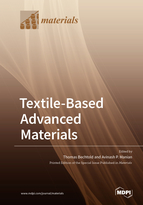Textile-Based Advanced Materials: Construction, Properties and Applications
A special issue of Materials (ISSN 1996-1944). This special issue belongs to the section "Materials Chemistry".
Deadline for manuscript submissions: closed (31 October 2020) | Viewed by 62462
Special Issue Editors
Interests: electrochemical processes; natural colorants; technical and apparel textiles
Special Issue Information
Dear Colleagues,
The field of textiles is not limited only to apparel and fashion, and has applications in many more areas. The sector possesses an array of technologies to physically engineer fibrous materials into structures; to combine disparate materials to create hybrids, composites and blends; and for their chemical treatment. The results find applications in such diverse areas as medicine, physical well-being, sports, smart materials, engineering, energy storage, etc. This Special Issue focuses on such areas. The scope includes methods of construction, chemical processing, property characterizations and validation tests in targeted applications. We welcome both review and experimental articles on the topic.
Prof. Dr. Thomas Bechtold
Dr. Avinash P. Manian
Guest Editors
Manuscript Submission Information
Manuscripts should be submitted online at www.mdpi.com by registering and logging in to this website. Once you are registered, click here to go to the submission form. Manuscripts can be submitted until the deadline. All submissions that pass pre-check are peer-reviewed. Accepted papers will be published continuously in the journal (as soon as accepted) and will be listed together on the special issue website. Research articles, review articles as well as short communications are invited. For planned papers, a title and short abstract (about 100 words) can be sent to the Editorial Office for announcement on this website.
Submitted manuscripts should not have been published previously, nor be under consideration for publication elsewhere (except conference proceedings papers). All manuscripts are thoroughly refereed through a single-blind peer-review process. A guide for authors and other relevant information for submission of manuscripts is available on the Instructions for Authors page. Materials is an international peer-reviewed open access semimonthly journal published by MDPI.
Please visit the Instructions for Authors page before submitting a manuscript. The Article Processing Charge (APC) for publication in this open access journal is 2600 CHF (Swiss Francs). Submitted papers should be well formatted and use good English. Authors may use MDPI's English editing service prior to publication or during author revisions.
Keywords
- medical
- engineering
- composites
- smart
- energy
- sports
- ageing







